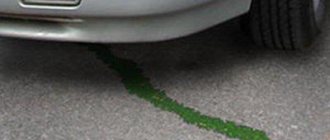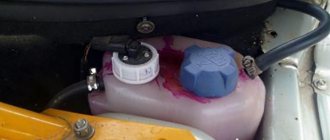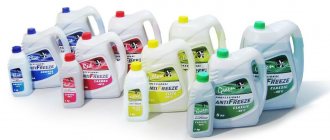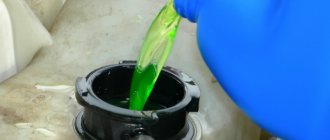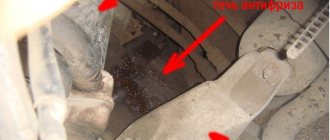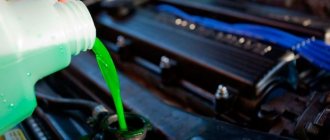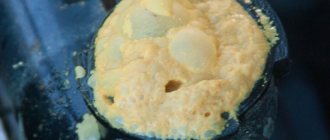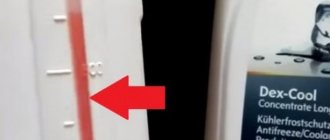Antifreeze is needed to cool a car engine. Today, coolants are classified into 4 types, each of which differs in additives and certain properties. All the antifreeze you see on store shelves is made up of water and ethylene glycol, and that's where the similarities end. So how do coolants differ from each other, in addition to color and cost, choose the right antifreeze for your car, is it possible to mix different coolants and dilute them with water - read on.
What is special about G12 antifreeze
service life compared to antifreeze or antifreeze G11 . G12 does not contain silicates; it is based on ethylene glycol and carboxylate compounds. Thanks to the additive package, on the surface inside the block or radiator, corrosion is localized only where necessary, forming a resistant micro film. Often this type of antifreeze is poured into the cooling system of high-speed engines. Mixing g12 antifreeze and coolant of another class is unacceptable .
But it has one big disadvantage - G12 antifreeze begins to act only when a source of corrosion has already appeared. Although this action prevents the appearance of a protective layer and its rapid shedding as a result of vibrations and temperature changes, which makes it possible to improve heat transfer and longer use.
The main differences between the G12 coolant and the points
- The composition includes organic additives that do not have a destructive effect on metal surfaces. Antifreeze G12 activates its protective properties in areas of corrosion damage, and G11 forms a film on all elements of the cooling system.
- Production is based on more complex and advanced carbosilicate technology. The compositions of the “G 11” group are created on the basis of the silicate process.
- Long service life and stability. Unlike G11, it does not create abrasive residue when its service life expires.
- Has more efficient heat transfer performance.
- Can be used in modern cars with aluminum cylinder heads and radiators.
- Increased boiling point, which creates good conditions for active vehicle operation in difficult conditions.
- The only difference from the more progressive G13 is the dangerous base, but if you take precautions, this drawback is almost completely eliminated.
Main technical characteristics of class G12
It is a homogeneous transparent liquid without mechanical impurities of red or pink color. Antifreeze G12 is ethylene glycol with the addition of 2 or more carboxylic acids; it does not form a protective film, but affects already formed areas of corrosion. Density is 1.065 – 1.085 g/cm3 (at 20°C). The freezing point is within 50 degrees below zero, and the boiling point is about +118°C. Temperature characteristics depend on the concentration of polyhydric alcohols (ethylene glycol or propylene glycol). Often, the percentage of such alcohol in antifreeze is 50-60%, which allows for optimal performance. Pure, without any impurities, ethylene glycol is a viscous and colorless oily liquid with a density of 1114 kg/m3 and has a boiling point of 197°C, and freezes at 13°C. Therefore, dye is added to antifreeze to give it individuality and greater visibility of the liquid level in the tank. Ethylene glycol is a strong food poison, the effect of which can be neutralized with ordinary alcohol.
Remember that coolant is deadly to the body. To cause death, 100-200 g of ethylene glycol will be enough. Therefore, antifreeze should be hidden as far as possible from children, because the bright color, similar to a sweet drink, is of great interest to them.
Refrigerant properties
Almost 95%! all antifreezes are the same. The basis of all refrigerants is ethylene glycol (propylene glycol), which is an oily liquid with a boiling point of +2000C and a freezing point of -12.30C. To enhance the characteristics of antifreezes, various additives are added to their base. Antifreeze class g12 is called carboxylate, since it contains carboxylic acid.
We recommend: What is a carburetor: device and purpose
ATTENTION! A completely simple way to reduce fuel consumption has been found! Don't believe me? An auto mechanic with 15 years of experience also didn’t believe it until he tried it. And now he saves 35,000 rubles a year on gasoline! Read more"
It is recommended to mix coolant with refrigerants from only one manufacturer, and softened water should also be used . Coolant inherently has protective properties:
- screening of destruction;
- enhanced heat exchange;
- used in shared vehicle fleets;
- reduces OS repair costs;
- protects the environment;
- prevents foaming;
- Neutral to gas hoses and varnished surfaces.
Concentrated antifreeze consists of 90%!ethylene glycol, 3%!softened water and 7%!various additives, the quality of which determines whether the electric motor will operate trouble-free or not.
What does G12 antifreeze consist of?
The G12 class antifreeze concentrate includes:
- dihydric alcohol ethylene glycol about 90% of the total volume, which is needed to prevent freezing;
- distilled water , about five percent;
- dye (color often identifies the class of coolant, but there may be exceptions);
- additive package of at least 5 percent, since ethylene glycol is aggressive towards non-ferrous metals, several types of phosphate or carboxylate additives based on organic acids are added to it, acting as an inhibitor to neutralize the negative impact. Antifreezes with different sets of additives perform their functions differently, and their main difference is in the methods of combating corrosion.
In addition to corrosion inhibitors, the set of additives in the G12 coolant includes additives with other necessary properties. For example, the coolant must have anti-foaming, lubricants and compounds that prevent the appearance of scale.
Advantages and disadvantages of G12 coolant
The advantages of the product include the following qualities:
- Provides more efficient cooling of the vehicle's power unit when compared with the compositions of the “junior” series. The increased characteristics are explained by the special composition of additives.
- The composition has improved heat transfer. This quality makes it a good option for machines that operate in difficult conditions.
- Long service life. If you follow the technology of flushing the system and replacing the coolant, then the antifreeze will not lose its quality for at least 5 years.
- Quickly eliminates pockets of corrosion and also protects weakened surfaces.
G12 coolants have only one drawback. It lies in the fact that carbosilicate additives begin to act only when areas affected by corrosion appear. Consequently, the preventive function of the composition is virtually absent. This drawback can be completely eliminated with the help of special modern auto chemical products.
What is the difference between G12 and G11, G12+ and G13
The main types of antifreeze, such as G11, G12 and G13, differ in the type of additives used: organic and inorganic.
General information about antifreeze, what is the difference between them and how to select the right coolant
Coolant class G11 of inorganic origin with a small set of additives, the presence of phosphates and nitrates. This antifreeze is created using silicate technology. Silicate additives cover the internal surface of the system with a continuous protective layer, regardless of the presence of corrosion areas. Although such a layer protects existing areas of corrosion from destruction . Such antifreeze has low stability, poor heat transfer and a short service life; after production, it precipitates, forming an abrasive and thereby damaging the elements of the cooling system.
Due to the fact that G11 antifreeze creates a layer similar to scale in a kettle, it is not suitable for cooling modern cars with radiators with thin channels. In addition, the boiling point of such a cooler is 105 ° C, and the service life is no more than 2 years or 50-80 thousand km. mileage
Often, G11 antifreeze is colored green or blue . This coolant is used for cars manufactured before 1996 and cars with a large cooling system.
G11 is not well suited to aluminum radiators and blocks, as its additives cannot properly protect this metal at high temperatures.
In Europe, the authoritative specification of antifreeze classes belongs to the Volkswagen concern, therefore the corresponding marking VW TL 774-C provides for the use of inorganic additives in antifreeze and is designated G 11. The VW TL 774-D specification provides for the presence of organic-based carboxylic acid additives and is marked as G 12. VW standards TL 774-F and VW TL 774-G are marked with classes G12 + and G12 ++, and the most complex and expensive antifreeze G13 is regulated by the VW TL 774-J standard. Although other manufacturers such as Ford or Toyota have their own quality standards. By the way, there is no difference between antifreeze and antifreeze. Antifreeze is one of the brands of Russian mineral antifreeze, which is not designed to work in engines with an aluminum block.
It is strictly forbidden to mix organic and inorganic antifreezes, since a coagulation process will occur and as a result a sediment in the form of flakes will appear!
And liquids of classes G12, G12 + and G13 are varieties of organic antifreeze “Long Life”. They are used in cooling systems of modern cars produced since 1996. G12 and G12 + are based on ethylene glycol, but only G12 plus involves the use of hybrid production technology, which combines silicate technology with carboxylate technology. In 2008, the G12++ class also appeared; this liquid has an organic base combined with a small amount of mineral additives (called lobrid Lobrid or SOAT coolants). In hybrid antifreezes, organic additives are mixed together with inorganic ones (silicates, nitrites and phosphates can be used). This combination of technologies made it possible to eliminate the main drawback of G12 antifreeze - not only eliminate corrosion when it has already appeared, but also perform a preventive effect.
G12+, unlike G12 or G13, can be mixed with liquid class G11 or G12, but still such a “mix” is not recommended.
Coolant class G13 began to be produced in 2012 and is designed for automobile engines operating in extreme conditions . From a technological point of view, it is no different from G12, the only difference is that it is made with propylene glycol , which is less toxic, decomposes faster, and therefore causes less harm to the environment when disposed of and its price is significantly higher than G12 antifreeze. It was invented based on the requirements for increasing environmental standards. G13 antifreeze is usually purple or pink, although in fact it can be painted in any color, since it is just a dye on which its characteristics do not depend; different manufacturers can produce coolant with different colors and shades.
The difference in the action of carboxylate and silicate antifreezes
Where and how are antifreezes used?
Antifreeze has found its application only in the field of automobile transport. It is often used in the heating system of residential buildings and premises. In our case, the main task of antifreeze is to maintain the operating temperature of the engine in a given mode. Coolant is used in a closed jacket of the engine and the line, and also passes through the passenger compartment, due to which warm air blows when the heater is on. Some cars have a heat exchanger for automatic transmissions, where antifreeze and oil intersect in parallel in one housing, regulating each other’s temperature.
Previously, cars used a coolant called “Antifreeze”, where the main requirements are:
- maintaining operating temperature;
- lubricating properties.
This is one of the cheapest liquids that absolutely cannot be used in modern cars. A number of antifreezes have already been invented for them: G11, G12, G12+(++) and G13.
G12 antifreeze compatibility
Is it possible to mix antifreezes of different classes and different colors? Quite a lot of inexperienced car owners who have purchased a used car and do not know what brand of coolant was poured into the expansion tank are interested.
If you only need to add antifreeze, then you should know exactly what is currently poured into the system, otherwise you risk having to repair not only the cooling system, but also the repair of the entire unit. It is recommended that you completely drain the old fluid and fill it with new one.
As we already figured out earlier, color does not affect the property, and different manufacturers can paint in different colors, but still, there are generally accepted standards . The most common antifreeze colors are green, blue, red, pink and orange. Some standards may even regulate the use of liquids of certain shades, but the color of antifreeze is the last criterion that should be taken into account. Although, it is often customary to designate green as the liquid of the lowest class G11 (silicate) . Therefore, say, mixing red and pink G12 antifreeze (carboxylate) is allowed, as well as antifreezes only on an organic basis or liquids only on an inorganic basis, but you need to know that different ones may have a different set of additives and chemicals. substances whose reactions cannot be predicted! This incompatibility of G12 antifreeze means there is a high probability that a reaction may occur between the additives included in their composition, which will be accompanied by precipitation or deterioration of the technical characteristics of the coolant.
Therefore, if you want to maintain engine performance, fill in antifreeze of the same brand and class, or completely drain the old fluid and replace it with a known one. A small addition of liquid can be done with distilled water .
If you want to switch from one class of antifreeze to another, then you should also flush the cooling system before replacing.
You may also be interested
Blue antifreeze
Blue antifreeze belongs to class G11 coolants. This is a very common type with a traditional composition. Most often, the first association with blue or turquoise coolant is TOSOL, which used to be poured into Soviet and now into domestic cars. But in terms of its characteristics, blue coolant is much better and of higher quality, since it has a more balanced composition.
Types, types and technical characteristics of antifreeze depending on the marking
The service life and performance of the engine are directly affected not only by the condition of the engine oil, but also by the quality of the coolant. Previously, antifreeze was popular, now car enthusiasts choose antifreeze. Each type has its own composition and even color. Why is it needed and how to choose it?
Which antifreeze to choose
When the question concerns the choice of antifreeze not only by color, but also by class, then it is recommended to use the one that the manufacturer indicates on the expansion tank or technical documentation of the car. Because if copper or brass was used in the manufacture of the cooling radiator (installed on older cars), then the use of organic antifreeze is undesirable.
Antifreeze can be of 2 types: concentrated and already diluted at the factory. At first glance, there doesn’t seem to be much difference, and many car enthusiasts advise taking the concentrate and then diluting it with distilled water, only observing the proportion (1 to 1 for our climatic conditions), explaining this by saying that what you are pouring is not a fake , but unfortunately, taking concentrate is not entirely correct. Not only because mixing at the plant occurs more accurately, but also because the water at the plant is filtered at the molecular level and distilled water seems dirty in comparison, so this can subsequently affect the appearance of deposits.
The concentrate cannot be used in its pure undiluted form, because it itself freezes at -12 degrees.
Mixing antifreezes of different types
To choose the ideal antifreeze composition, you need to consider what materials your car’s engine and radiator are made of, since the additives included in the composition react differently with aluminum, brass or copper parts, you may need to replace the fluid as soon as possible, regardless of the period its suitability. Carefully read the specifications for your car and choose antifreeze in accordance with the tolerance class indicated on the label.
When adding antifreeze, you need to rely not on the color of the liquid, but on its marking, so as not to mix different chemical elements contained in the additives.
Please note that if you mix liquids of different compositions, nothing terrible may happen, but sediment may form and the antifreeze will not cope with its main functions; in the near future a complete replacement will be required, and perhaps not only the antifreeze itself.
How to measure the density of antifreeze at home?
The measurement procedure using a hydrometer is quite simple. You need to fill the flask from a canister or directly from the cooling system with a sufficient amount of antifreeze for the float to float up. Next, look at the float. The level to which it sinks will mark the density. After measurement, it is enough to compare the density with the concentration of ethylene glycol corresponding to this density, or with the pour point.
There is another way to measure density at home. To do this, you will need fairly accurate scales (you can use kitchen scales) and a container with a volume of exactly 1 liter. The procedure for measuring density in this case will consist of the following steps:
- weigh the empty container and write down the result;
- pour exactly 1 liter of antifreeze into this container and carry out another weighing;
- subtract the container weight from the gross weight and get a net net of 1 liter of antifreeze;
This will be the density of the antifreeze. The method can claim accuracy only if the scales are guaranteed to show the correct mass, and the container holds exactly 1 liter of liquid.
Device for measuring antifreeze density
The density of antifreeze can be measured with a conventional hydrometer. This is the most suitable device. You just need to find a version of a hydrometer designed to measure the density of glycol mixtures.
The hydrometer consists of two main parts:
- flasks (with a rubber tip on one side and a bulb on the other) for taking antifreeze inside;
- float with scale.
Inside the hydrometer, which is directly designed to measure the density of antifreeze, there is usually a hint insert. It shows not only the density, but also the glycol concentration corresponding to it. Some, more modified versions, immediately provide information about the freezing point of the antifreeze being tested. This eliminates the need to independently search for values in the table and makes the procedure itself faster and more convenient.
Composition of antifreeze G11
This solution consists of additives of inorganic compounds. This class of antifreeze was used previously, and is currently used for cars manufactured before 1996. In fact, this is ordinary antifreeze.
This solution is capable of boiling at a temperature of 105 degrees, and the service life of these liquids is no more than 3 years, if you count the mileage, then 80 thousand km. These solutions were designed for machines with significant system capacity. Antifreeze creates a protective film in the cooling system that prevents parts from rusting. But because of this microfilm, heat conductivity is significantly reduced. This is a big drawback, often leading to overheating of the motors. For newer cars with small cooling system volumes, such fluids are not suitable. This is explained by the poorer thermal conductivity that G11 antifreeze is characterized by.
Its properties are much worse than other modern solutions. Typically, G11 antifreezes contain blue or green dye. This antifreeze is well suited for older cars with a volumetric cooling system. You should know that G11 antifreeze is not allowed for use on aluminum radiators. Such additives are not able to provide reliable protection of the cylinder block at elevated temperatures.
conclusions
- You shouldn’t rely on just the shade. The color of the cooling mixture alone cannot be considered a complete guarantee that the mixture meets safety standards.
- But still, it’s definitely worth adding the same product to the car that it already has. The ideal solution would be if it is exactly the same coolant in its composition, and it was recommended by the manufacturer.
- When mixing different types of antifreeze, certain difficulties may appear over time - this is provoked cavitation and so-called corrosion of the metal surface, it can also be blocking of motor channels and other breakdowns that can significantly reduce the engine's service life.
- Mix antifreeze with approximately equal base (antifreeze with ethylene glycol and ethylene glycol can be mixed with each other). At the same time, antifreezes obtained from the silicate-free group should not be added anywhere.
- Find the most suitable product for your engine and use only this antifreeze.
- 11th generation antifreeze - it is worth considering that this antifreeze usually has a green tint.
Characteristics of green antifreeze
In the production of green antifreeze, a special set of additives is used, made on a salt base of carboxylic acids. It is these additives that provide systemic protection for internal combustion engines against the formation of boiling products.
The composition may also include a dye with fluorescent properties, which is used to identify leak locations using ultraviolet rays. Green antifreeze meets the existing requirements for substances of this type, and is accompanied by characteristics similar to other products of the same purpose.
Many car owners wonder why additives are needed? After all, if you use water with ethylene glycol, there will be no boiling or freezing. It would seem like a good combination of components. However, if this mixture is used in the engine cooling system, then within a few months the composition will corrode metal and rubber tubes, the engine block and radiators. To eliminate these phenomena, various additives began to be used.
Of the features of the green coolant, the following is noted:
- phosphate film protects the walls inside the mechanism from the corrosive influence of ethylene glycol;
- prevent foaming in the expansion tank;
- reduces the corrosive effect.
Green automotive fluid needs regular replacement every two to three years, since after a short period of time the adhered particles fall off and clog small system channels. In addition, due to film formation, heat dissipation is reduced.
